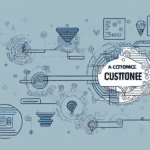The Importance of Efficient Parcel Delivery in E-Commerce
Efficient parcel delivery is a vital component of e-commerce operations, directly affecting customer satisfaction, retention, and overall profitability. In today's competitive market, customers expect their orders to arrive promptly and in perfect condition. Delays or damaged deliveries can lead to dissatisfied customers, negative reviews, and lost sales. Conversely, swift and reliable parcel delivery fosters customer loyalty and advocacy, resulting in repeat business and positive word-of-mouth marketing. According to a PwC Consumer Intelligence Series, 79% of customers are more likely to return to an e-commerce store that offers reliable delivery services.
Impact on Customer Satisfaction
Customer satisfaction is a key metric for e-commerce businesses as it influences repeat purchases and brand reputation. With numerous online options available, customers have heightened expectations regarding delivery services. Inefficient parcel delivery can severely impact customer satisfaction, leading to negative feedback and lost sales. A study by MetaPack revealed that 66% of customers would not return to an e-commerce store after a negative delivery experience.
Providing real-time tracking information is one effective way to enhance parcel delivery satisfaction. It allows customers to monitor their package's journey and anticipate its arrival, thereby improving their overall experience. Additionally, offering multiple delivery options, such as same-day or next-day delivery, gives customers greater control over their delivery preferences, further boosting satisfaction.
The condition of the package upon arrival also plays a crucial role in customer satisfaction. Ensuring that packages are securely and appropriately packaged can prevent damage during transit. Clear instructions for handling and disposing of packaging materials can also enhance the customer's unboxing experience.
Balancing Speed and Cost
One of the primary challenges in parcel delivery for e-commerce is finding the right balance between speed and cost. While fast deliveries improve customer satisfaction, they can also increase operational expenses. Conversely, cost-efficient deliveries may result in longer delivery times, potentially impacting customer satisfaction.
To achieve an optimal balance, businesses can:
- Optimize Delivery Routes: Efficient routing reduces delivery times and operational costs.
- Utilize Real-Time Tracking Information: Enables better planning and resource allocation.
- Leverage Technology to Streamline Operations: Automation and advanced logistics software can enhance efficiency and reduce costs.
Implementing these strategies allows businesses to meet customer expectations for timely deliveries while maintaining cost-effectiveness, ultimately maximizing profitability.
Strategies and Best Practices for Optimizing E-Commerce Logistics
To streamline e-commerce logistics through parcel delivery, consider implementing the following strategies:
- Selecting the Right Parcel Delivery Service Provider: Choose a provider that aligns with your business requirements and offers reliable services.
- Optimizing Delivery Routes: Efficient routing minimizes delivery times and reduces operational costs.
- Investing in Technology and Automation: Utilize technologies like automated sorting and real-time tracking to improve operational efficiency.
- Providing Accurate and Real-Time Tracking Information: Keep customers informed about their delivery status to enhance their experience.
- Establishing Clear Communication Channels with Delivery Partners: Effective communication ensures smooth operations and timely deliveries.
Implementing these strategies can lead to reduced delivery times, minimized errors, and an enhanced overall customer experience. Additionally, establishing a returns management system can simplify the returns process, benefiting both your business and your customers.
Inventory Management and Order Fulfillment
Effective inventory management and order fulfillment are closely linked to efficient parcel delivery. Implementing robust inventory management systems provides real-time visibility into stock levels, reducing the risk of stockouts and overstocking. Segmenting inventory based on product demand, sales velocity, and expiration dates can improve efficiency.
Automating order fulfillment processes minimizes errors and accelerates the order processing cycle. Integrating logistics and delivery operations with your e-commerce platform facilitates seamless end-to-end operations, enhancing overall efficiency. Providing accurate and timely information to customers about stock availability, expected delivery dates, and shipping status also improves their experience.
Choosing the Right Parcel Delivery Service Provider
Selecting the appropriate parcel delivery service provider is crucial for optimizing e-commerce logistics. With numerous options available, consider the following key factors:
- Coverage and Network: Ensure the provider covers your delivery locations and has a robust network to facilitate timely deliveries.
- Delivery Times and Options: Verify that the provider offers delivery times and options that meet your business and customer needs.
- Pricing and Fees: Compare the pricing structures and fees of different providers to identify the most cost-effective solution.
- Technology and Support: Look for providers that invest in advanced technologies and offer excellent customer support.
- Reputation and Reviews: Assess the provider's reputation and read online reviews to gauge their reliability and service quality.
By carefully evaluating these factors, you can select a parcel delivery service provider that enhances your logistics operations and supports your business growth.
Building Strong Relationships with Delivery Providers
Building strong relationships with parcel delivery providers is essential for optimizing e-commerce logistics. Strong partnerships can lead to improved communication, access to integrated technologies, better terms, and enhanced delivery performance. Here are some ways to foster these relationships:
- Establish Clear and Consistent Communication Channels: Ensure timely and accurate delivery information by maintaining open lines of communication.
- Invest in Joint Technology and Infrastructure Initiatives: Collaborate on technology and infrastructure projects to improve operational efficiency.
- Provide Regular Feedback and Performance Metrics: Help delivery partners improve their service quality by sharing performance data and feedback.
- Collaborate on Joint Marketing and Promotional Activities: Boost awareness and sales through collaborative marketing efforts.
- Develop Long-Term Partnerships Based on Shared Goals and Values: Foster trust and mutual benefits by aligning your business objectives with those of your delivery providers.
By nurturing strong relationships with parcel delivery providers, businesses can enhance their delivery performance and gain a competitive advantage in the e-commerce market.
Trends and Innovations in Parcel Delivery for E-Commerce Businesses
Parcel delivery has undergone significant transformations in recent years, driven by technological advancements and changing consumer expectations. Key trends and innovations include:
- Drone and Autonomous Delivery: Unmanned aerial vehicles and ground robots are being utilized for last-mile deliveries, enhancing speed and efficiency.
- Sustainable and Eco-Friendly Delivery: The use of electric and hybrid vehicles, bike couriers, and alternative fuel sources is reducing the carbon footprint of delivery operations.
- Virtual and Augmented Reality-Enabled Delivery: These technologies offer customers immersive experiences related to product delivery and tracking.
- Social Media and Mobile-Enabled Delivery: Integration with social media and mobile apps allows customers to order and track deliveries seamlessly.
Adopting these trends and innovations can help e-commerce businesses enhance their delivery operations, differentiate themselves in the market, and meet the evolving expectations of their customers.
Mitigating Risks and Challenges in E-Commerce Logistics Through Parcel Delivery
E-commerce logistics faces various risks and challenges that can affect parcel delivery efficiency and customer satisfaction. Common challenges include:
- Logistical Issues: Problems such as stock availability, order accuracy, and inventory management can disrupt the delivery process.
- Delivery-Related Issues: Delays, package damage, and theft can negatively impact customer experience.
- Regulatory and Compliance Issues: Navigating customs, taxation, and other regulatory requirements is essential for smooth operations.
- Environmental and Sustainability Issues: Managing carbon emissions and waste is increasingly important for both businesses and consumers.
To mitigate these risks and challenges, e-commerce businesses should:
- Conduct Regular Audits: Regularly reviewing operations helps identify and address potential issues proactively.
- Invest in Robust Security Measures: Ensuring the security of packages during transit minimizes risks of theft and damage.
- Comply with Regulations and Standards: Adhering to relevant laws and standards ensures smooth and legal operations.
By taking these proactive steps, businesses can enhance the reliability of their parcel delivery services and maintain high levels of customer satisfaction.
Leveraging Data Analytics and Technology to Improve E-Commerce Logistics
Data analytics plays a pivotal role in optimizing e-commerce logistics and delivery operations. By analyzing data from various sources, such as customer feedback, delivery tracking information, and supply chain metrics, businesses can identify areas for improvement and implement targeted solutions.
- Identify Patterns in Delivery Delays: Understanding the reasons behind delays helps in optimizing routing strategies.
- Predict Seasonal Spikes in Demand: Accurate forecasting allows for better inventory and resource planning.
- Enhance Customer Insights: Analyzing customer behavior helps in tailoring delivery services to meet their preferences.
Investing in data analytics tools and expertise enables e-commerce businesses to make data-driven decisions, thereby improving logistics efficiency and boosting competitiveness.
Role of Technology
- Delivery Management Software: Helps manage delivery routes, schedules, and expenses efficiently, reducing operational costs.
- Data Analytics Tools: Provide insights into customer behavior, logistics operations, and supply chain data, enabling informed decision-making.
- Inventory Management Systems: Offer real-time visibility into stock levels, optimizing order fulfillment processes.
- Digital Platforms and Marketplaces: Expand your reach to more customers and enhance your delivery network.
- Automation and Robotics: Increase speed, accuracy, and efficiency in logistics and delivery operations, reducing human error.
By adopting these technologies, e-commerce businesses can enhance their parcel delivery performance, reduce costs, and improve overall customer satisfaction.
Case Studies: Successful Implementation of Optimized Parcel Delivery Strategies in E-Commerce
Numerous e-commerce businesses have successfully optimized their parcel delivery strategies to enhance logistics operations. Notable examples include:
- Amazon: Invested heavily in automation, robotics, and drone delivery systems to improve speed and accuracy, enabling faster deliveries and reducing operational costs.
- Alibaba: Developed a vast network of agents and partners to offer more reliable and faster deliveries across China, catering to the high demand during peak shopping seasons.
- Zappos and Nordstrom: Prioritized customer experience by offering free and expedited delivery options, fostering high levels of customer satisfaction and loyalty.
These case studies demonstrate the benefits of implementing optimized parcel delivery strategies. By learning from industry leaders and adopting best practices, businesses can enhance their parcel delivery performance and achieve better overall logistics efficiency.
In conclusion, optimizing e-commerce logistics through effective parcel delivery is essential for enhancing customer satisfaction, loyalty, and profitability. By adopting the strategies and best practices outlined in this article, businesses can streamline their logistics operations, mitigate risks, leverage data analytics and technology, and build strong relationships with delivery providers. These efforts will help establish a competitive edge and ensure success in the highly competitive e-commerce landscape.






















